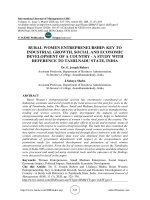Economic growth and economic development 651
Bạn đang xem bản rút gọn của tài liệu. Xem và tải ngay bản đầy đủ của tài liệu tại đây (139.96 KB, 1 trang )
Introduction to Modern Economic Growth
and ω (t) ≥ 0, with complementary slackness, where
(14.48)
ω (t) ≡
w (t)
Y (t)
is the labor share at time t. The labor market clearing condition, (14.47), uses the
fact that total supply is equal to 1, and the demand cannot exceed this amount. If
demand falls short of 1, then the wage rate, w (t), and thus the labor share, ω (t),
have to be equal to zero (though this will never be the case in equilibrium). The
right-hand side of (14.47) consists of the demand for production (the terms with ω in
the denominator), the demand for R&D workers from the neck-and-neck industries
(2G (z0 (t)) when n = 0) and the demand for R&D workers coming from leaders and
followers in other industries (G (zn (t)) + G (z−n (t)) when n > 0).
The relevant index of aggregate quality in this economy is no longer the average,
but reflects the Cobb-Douglas aggregator in the production function,
Z 1
ln q (ν, t) dν.
(14.49)
ln Q (t) ≡
0
Given this, the equilibrium wage can be written as (see Exercise 14.22):
(14.50)
w (t) = Q (t) λ−
P∞
n=0
nµn (t)
.
14.3.3. Steady-State Equilibrium. Let us now focus on steady-state (Markov
Perfect) equilibria, where the distribution of industries µ (t) ≡ {µn (t)}∞
n=0 is sta-
tionary, ω (t) defined in (14.48) and g∗ , the growth rate of the economy, is constant
over time (we refer to this as a steady-state Markov perfect equilibrium, since the
potentially more accurate term “balanced growth path Markov perfect equilibrium”
sounds awkward). We will establish the existence of such an equilibrium and characterize a number of its properties. If the economy is in steady state at time t = 0, then
by definition, we have Y (t) = Y0 eg
∗t
and w (t) = w0 exp (g ∗ t). The two equations
also imply that ω (t) = ω ∗ for all t ≥ 0. Throughout, we assume that the parameters
are such that the steady-state growth rate g ∗ is positive but not large enough to
violate the transversality conditions. This implies that net present values of each
firm at all points in time will be finite and enable us to write the maximization
problem of a leader that is n > 0 steps ahead recursively.
637









